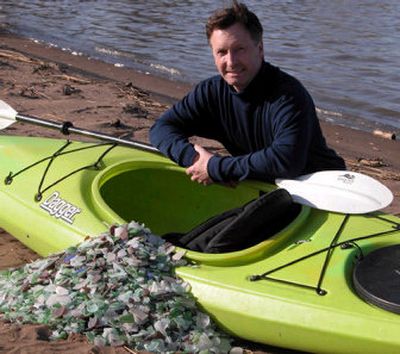Sea glass is hot

Not long ago, sea glass was just something you plunked in a plastic pail, along with shells and baby crabs, when you were taking a beach walk with Grandma.
Today, those frosted, shimmery shards – softened and smoothed by decades underwater – are being sought by collectors, artisans and would-be archeologists. Bags of sea glass are sold by the pound on eBay. Chunks of light-catching greens and ambers are crafted into (frequently pricey) earrings and bracelets. Some collectors have grouted their glass finds into kitchen backsplashes. Manufactured glass tiles for shower stalls and bathroom floors by high-end purveyors such as Ann Sacks have been cut and colored to mimic the real thing. Watery, serene shades of oceanic blues and greens are among Benjamin Moore’s most popular paint colors this year and are showing up in room after room in shelter magazines and show houses.
Maryland’s Chesapeake Bay – for centuries a shipping channel where bottles aplenty were tossed overboard – is one of the best places in the country to find this treasure from the sea, according to Chestertown writer Richard LaMotte, 45, author of the new book “Pure Sea Glass.”
LaMotte, 45, spent hundreds of hours combing beaches and trolling remote shorelines looking for the elusive pieces of the past. After particularly fierce storms in the bay, LaMotte hauls out his lime green kayak and paddles to a deserted stretch of beach he knows, training his eyes along the water’s edge for sun sparkling on bits of icy amethyst, jade or citron among the rocks and driftwood. A day’s haul, he says, often includes glass fragments or bottle stoppers that have been churning underwater for more than 100 years.
Like any canny collector, LaMotte won’t divulge the best spots where he and his wife, Nancy, have salvaged the 30,000 specimens they have in their home. But his self-published book (Chesapeake Sea Glass Publishing, 224 pages, $34.95) describes where sea glass comes from, how it is formed, and how to find and identify it. The text is lavishly illustrated with photographs by Celia Pearson, of Annapolis, Md.
Pearson produced a series of art photography prints of beach glass that are selling briskly for $300 to $1,700. “These pieces have a story like a message in a bottle,” says Pearson. “This glass has been on a journey.”
Since writing the book, which has sold an impressive 19,000 copies, LaMotte says he has discovered something of a cult of sea-glass groupies who fill bowls, bags and windowsills with multicolored shards. People show up at book signings with fistfuls of glass, some pieces dating back generations, curious to learn more about their history.
“There seems to be a nostalgic, emotional attachment to memories of collecting sea glass,” LaMotte says. “It takes people back to a childhood activity at a very happy time.”
Last fall, hundreds attended the Northeast Sea Glass Festival in Rockport, Mass.; another is planned for next year. Earrings, rings and bracelets made of glass polished by the sea, long popular in beachy boutiques and nature shops, are moving into high-end specialty stores. And rare red or orange sea glass, which sold for $5 or $10 a few years ago, is now fetching $50 to $100 apiece for good specimens.
The LaMottes’ enthusiasm grew from a small jar of sea glass they had collected with their daughter and son at the Outer Banks years ago. In 2000, Nancy, who had studied jewelry making, was looking for a second career, and decided to incorporate sea glass in her designs.
Richard, who works in his family’s water-testing company, started roaming the Chesapeake beaches looking for glass. On a good day, he says, he can find 100 to 150 pieces in his special spots, many of which are between Rock Hall and Great Oak on the Chesapeake Bay. As he found more and more pieces in different colors, he became curious as to their provenance and began researching the history of American glass bottles.
Sea glass, he discovered, is found in bodies of water large and small worldwide. Transforming a shard of glass into a soft-edged jewel takes a lot of water in motion swirling it and twirling it until it is weathered and frosted. He believes it takes up to 10 years for a sliver of glass to show significant etching, 20 to 30 years for edges to be completely polished and rounded by lapping waters.
The colors and sometimes the shape provide the keys to the glass’ age and history.